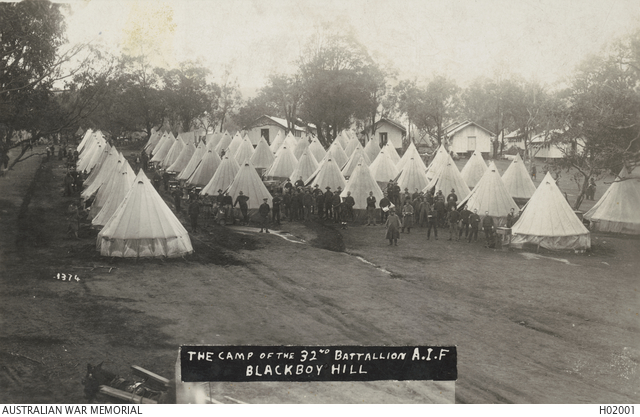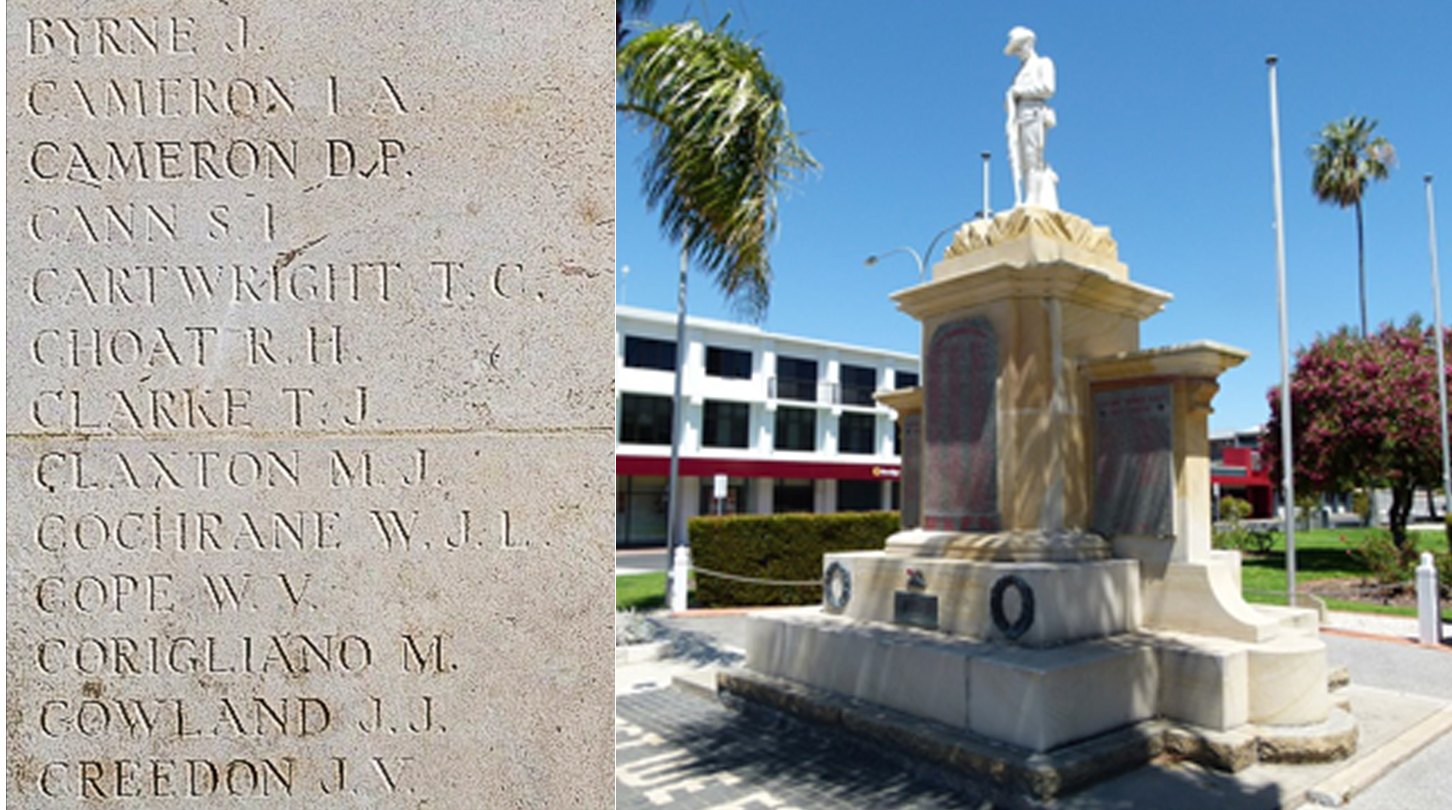Walter Vernon COPE
Eyes brown, Hair fair, Complexion medium
Wally Cope – “The boy did his bit”
With thanks to Geoff Tilley – In search of Charles Albert Stokes DCM - for his contribution towards this story.
Can you help us identify Walter?
Walter Vernon Cope was killed in Action at Fromelles. As part of the 32nd Battalion he was positioned near where the Germans collected soldiers who were later buried at Pheasant Wood. There is a chance he might be identified, but we need help. We are still searching for suitable family DNA donors.
In 2008 a mass grave was found at Fromelles, a grave the Germans dug for 250 (Australian) bodies they recovered after the battle.
If you know anything of contacts here in Australia or in Staffordshire, England, please contact the Fromelles Association.
See the DNA box at the end of the story for what we do know about his family.
The Soldier and His Family
Walter Vernon Cope, “Wally”, was born in Geraldton, Western Australia on 22 June 1892 to Walter James and Mary Adeline Cope (nee Birch). Wally was the second oldest of their five surviving children. Wally’s father had come to Australia from England in 1886 and his mother was born in Perth. Walter (senior) was working as an auctioneer and commission agent for Broadhurst and McNeil Merchants of Geraldton in 1901.
Around 1903 the family moved to Bunbury because his father began working as Secretary of the Bunbury Harbor Board. Wally must have been pretty industrious, based on an article in the local paper about his and his friends’ woodworking.
Wally first attended the Geraldton State School and then the Bunbury State School. His father noted that he had an interest in both clerical and architectural areas, although he did go on to work as a Clerk. In 1914 he was living at Hay Street, West Perth, per the electoral rolls.
Off to War
With ‘War Fever’ well established by mid-1915, Wally enlisted in late July. He was assigned to the newly formed 32nd Battalion D Company and was sent to the Blackboy Camp outside of Perth to begin his military training.
The 32nd Battalion had been formed at Mitcham, South Australia and was made up of two companies from Western Australia and two from South Australia. The men from WA were moved to Adelaide at the end of August to form the full battalion. Whilst stationed in Adelaide for training, Wally become friends with Miss Eva Gertrude Noell and they remained in contact after Wally left. The 32nd headed for Egypt from Adelaide aboard the HMAT Geelong A2 on 18 November 1915. There was much public support for the new battalion, as reported in The Adelaide Register:
“The 32nd Battalion went away with the determination to uphold the newborn prestige of Australian troops, and they were accorded a farewell which reflected the assurance of South Australians that that resolve would be realized.”
Egypt
Wally arrived in Suez on 14 December 1915 and was settled into the El Ferdan Camp just before Christmas. A month later they marched to Ismailia, then to the large camp at Tel el Kebir for February and most of March. The next stop was at Duntroon Plateau and Ferry Post until the end of May, training and guarding the Suez Canal. Their last posting in Egypt was a few weeks at Moascar. One soldier’s diary complained of being “sick up to the neck of heat and flies”, of the scarcity of water during their long marches through the sand and he described some of the food as “dog biscuits and bully beef”.
He did go on to mention good times as well with swims, mail from home, visiting the local sights and the like. Source AWM C2081789 Diary of Theodor Milton PFLAUM 1915-16, page 29, page 12 During their time in Egypt, the 32nd had the honour of being inspected by H.R.H. Prince of Wales.
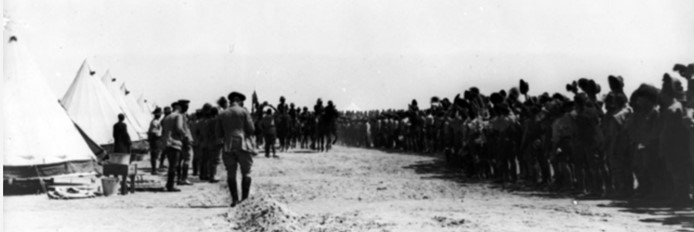
After spending six months in Egypt, the call to support the British Expeditionary Force on the Western Front came in mid-June. They left from Alexandria on the Transylvania on 17 June 1916 and arrived at Marseilles, France on 23 June 1916.
Fromelles
They then had a two-day train trip to Steenbecque. Their route took them to a station just out of Paris, within sight of the Eiffel Tower, through Bologne and Calais, with a view of the Channel, before they disembarked and marched to their camp at Morbecque, about 30 kilometres from Fleurbaix. Fellow soldier Theodor Pflaum (No. 327) wrote about the trip in his diary:
“The people flocked out all along the line and cheered us as though we had the Kaiser as prisoner on board!!”
Training continued with a focus on bayonets and the use of gas masks, assuredly with a greater emphasis, given their position near the front. On 14 July they moved to the front and Wally was into the trenches for the first time two days later, only three weeks after arriving in France. Three days later, they were reconnoitering the trenches and cutting passages through the wires, preparing for an attack, but it was delayed due to the weather.
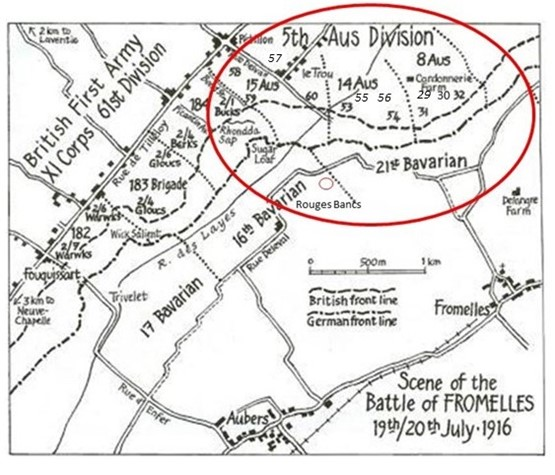
The overall plan for the area was to use Brigades from the Australian Fifth Division to conduct a diversionary assault of the German trenches at Fromelles. Wally’s battalion was to assault the German trenches on the left flank, crossing 100 metres of no man’s land to get the German trenches. As they advanced, they were to link up with the 31st Battalion on their right. However, their position on the extreme left flank made their job more difficult. Not only did they have to protect themselves while advancing, but they also had to block off the Germans on their left, to stop them from coming around behind them.

All were in position by 5.45 PM on the 19th and the charge over the parapet began at 5.53 PM. Wally’s D Company, along with B Company, formed the third and fourth waves of the attack. The men were able to capture the German frontline trenches opposite them and were able to take out a German machine gun in their early advances, but they were being “seriously enfiladed” from their left flank. By 8.30 PM their left flank had come under heavy bombardment with high explosives and shrapnel. Return bombardment support was provided and the 32nd was told that “the trenches were to be held at all costs”.
Source AWM4 23/49/12, 32nd Battalion War Diaries, July 1916, page 12
Pushing onto their final objectives, they found the support trenches turned out to be just ditches or abandoned trenches overgrown with grass and half full of water. With the advances that had been made earlier and the heavy casualties from continued German counterattacks during the night, their rear (Trench E) had been left almost empty. The Australians maintained their positions until about 3.45 AM before being surrounded. At this time the Australians decided to withdraw from the trenches, but they had to fight their way back to their lines. Having only a few grenades left, the only resistance they could offer was with rifles.
“The enemy swarmed in and the retirement across No Mans’ Land resembled shambles, the enemy artillery and machine guns doing deadly damage.”
What was left of the 32nd had finally withdrawn by 7.30 AM on the 20th. The initial roll call count was devastating – 71 killed, 375 wounded and 219 missing, including Wally.
The final impact was that 225 soldiers of the 32nd Battalion were killed or died from wounds sustained at the battle and, of this, 166 were unidentified. D Company Lieutenant Sam Mills survived the battle. In his letters home, he recalls the bravery of the men:
“They came over the parapet like racehorses……… However, a man could ask nothing better, if he had to go, than to go in a charge like that, and they certainly did their job like heroes."
News from the Battle Unfolds…Slowly
Wally did not return from the battlefield and was reported as missing. This was quickly communicated to his family, but there was no further information available.
The local papers ran an article about him being missing and it cited:
“I am afraid the boy is dead, but I know that if it is so he died a hero’s death.”
In September 1916 Walter’s father wrote to the Army requesting information on his son’s fate. With the large number of casualties at Fromelles, all the Army could reply was:
“Reported missing 20/07/1916, and no further information has since come to hand.
You will be promptly notified of any further reports.”
By the end of January information about Wally did start to become available, but unsurprisingly, none of it was good news. Wally’s fate during the attack had been witnessed by a number of his fellow soldiers.
Private C. Morris (1324) was in the same platoon as Wally and on 29 January 1917, he stated:
“I saw him shot and fall in no man’s land. But I do not know for certain if he died. He was left lying there.”
In March, Major Richard A. Geddes provided further information that he last saw Wally at 10 PM, fighting in the German trenches, but he was “certain that the lad was dead”.
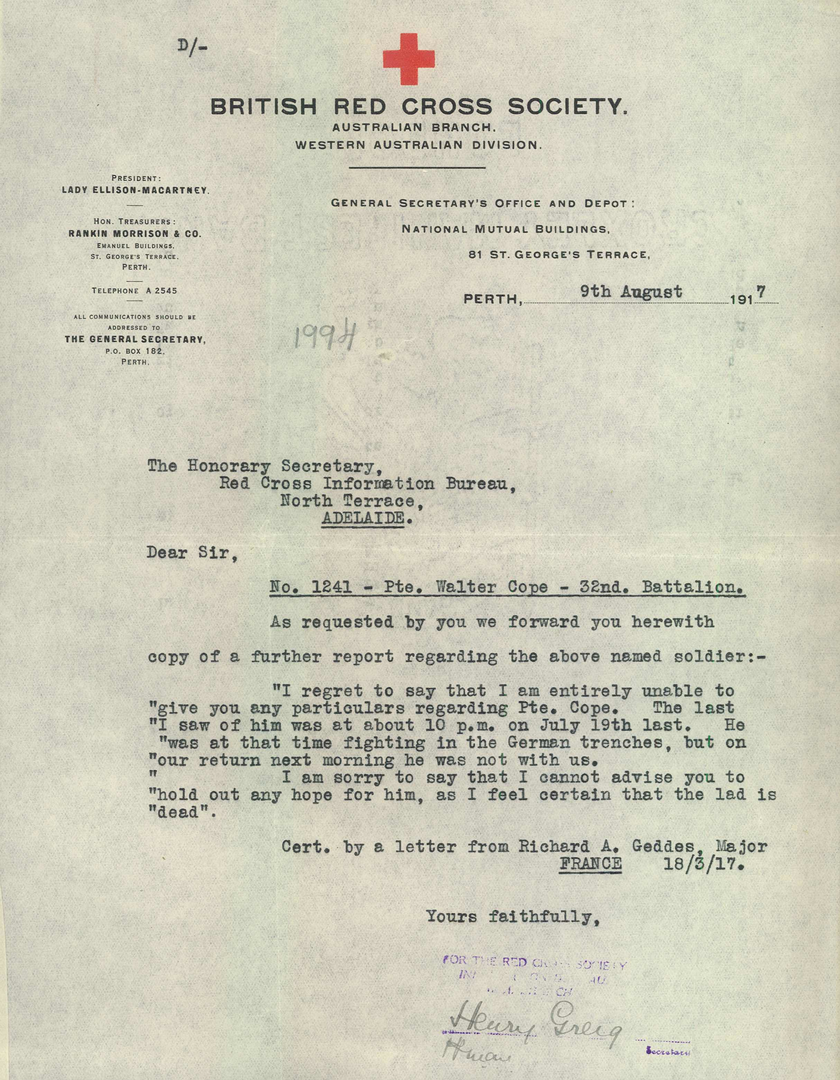
Apparently, the witness statements were not provided to the family. However, the family had received personal letters from Wally’s mates, providing what they knew of his fate. No doubt this caused further anxiety to Wally’s family and his father his letter to the Army wrote the Army again on 19 July 1917:
“It is just a year to-day since the lad went into action and nothing more has been heard of he and many of his comrades in the 32nd.
I have had several letters from lads who know my son but all they can say is that he was seen in the trenches in a hand to hand struggle with the enemy but did not return the next morning when the roll was called.
The boy did his bit as you will see from the enclosed cutting (from Major Geddes).”
Enquiries were also made to see if he was taken as a prisoner of war by the Germans - “No Trace Germany”. Even Gertrude Noell, the girl in Adelaide he had been friends with before he left, had been seeking news about Wally. In an April 1917 letter to the Red Cross she said, “we must hope for the best”
Source South Australian Red Cross Information Bureau - Walter Vernon Cope
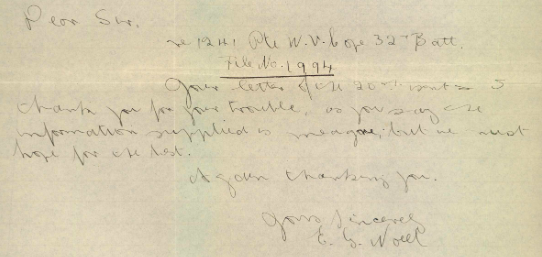
It was not until a court of inquiry was held ‘in the field’ on 12 August 1917 that Private Walter Vernon Cope, 32nd Battalion D Company, was pronounced as Killed in Action on 20 July 1916.
Five years later the Cope family and were still seeking information about Wally’s final resting place and they received a communication from the Officer in Charge of Base Records:
“Dear Sir, I regret very much that, notwithstanding the efforts of our Graves Services Unit, we have so far been unable to find any trace of the last resting place of your son the late No. 1241, Private W.V. Cope, 32nd Battalion.”
They also asked if the family had anything to offer, but Wally’s father could only reply:
“No belongings whatsoever (personal or military) have been sent from France, no information gleaned as to how my son met his death.”
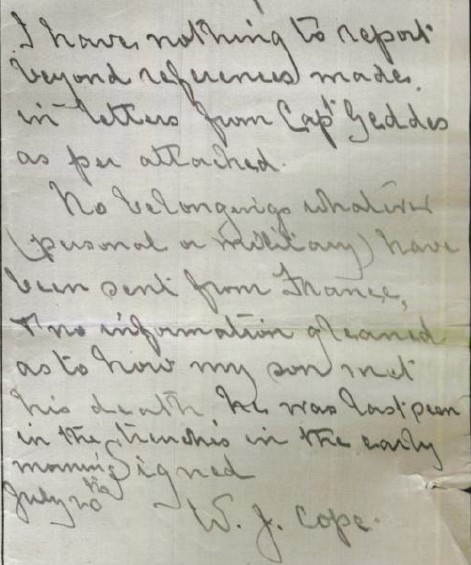
Wally was 24 years old. He received the 1914/15 Star Medal, the British War Medal, the Victory Medal, a Memorial Plaque and a Memorial Scroll.
He is commemorated at:
- V.C. Corner Australian Cemetery Memorial (Panel 5) in Fromelles,
- The Bunbury War Memorial
- The Australian War Memorial, Canberra.
Can Wally Ever be Found?
As of 2024, 41 of the 166 unidentified soldiers from the 32nd have been found to be in the German mass grave at Pheasant Wood that was discovered in 2008. Identification has been able to be made from DNA matching from contributions from family members. Wally may be one of the 70 yet unidentified soldiers of the 250 soldiers who were in the grave. We need to find family members to contribute DNA samples to find out if this was Wally’s final resting place from the battle to see if closure can finally be given to the family.
DNA samples are being sought for family connections to Wally Cope. We are particularly seeking family of Arthur Hugh Mahon (1995 – 1975) and Marie Grace Fels 1897 – 1958).
| Soldier | Walter Vernon Cope (1892-1916), b Geraldton, WA |
| Parents | Walter Vernon Cope (1863-1946), b Staffordshire, England, d Perth, WA and Mary Adeline Birch (1869 – 1956), b Perth, WA, d Perth, WA |
| Siblings | |||
| Constance Muriel (1890-1970), b Geraldton, d Perth, m Robert Smith | |||
| Gerald Vere (1894-1896), b Geraldton, d Geraldton | |||
| Mavis Gwendoline (1897-1970) b Perth, d Perth, m Arthur Thomas | |||
| Leonard James (1903-1934), b Bunbury, d Perth |
| Grandparents | |||
| Paternal | James Cope (1833-1884), b Staffordshire, England and Ann Gilbert (1835-1865) | ||
| Maternal | Vernon Brown Birch (1839-1901), b Staffordshire, England, d Perth, WA and Mary Elizabeth Lazemby (1845-1930), d Perth, WA |
Seeking DNA Donors

Contacts
(Contact: carla@fromelles.info or geoffrey@fromelles.info).
(Contact: army.uwc@defence.gov.au or phone 1800 019 090).
Donations
If you are able, please contribute to the upkeep of this resource.
(Contact: bill@fromelles.info ).



